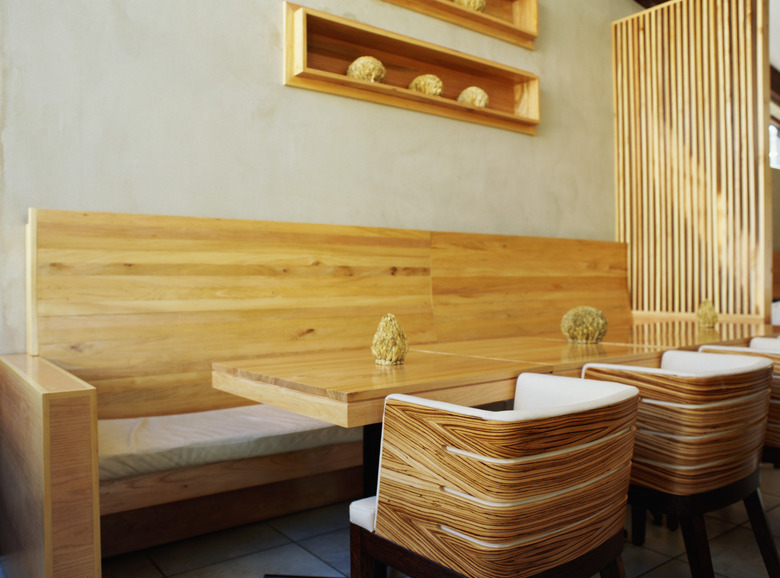DIY Lacquer On Plywood
Things Needed
-
Pad sander
-
Rags
-
150-, 220- and 320-grit sandpaper
-
Sanding sealer
-
Lacquer
-
Wax or polishing compound
Tip
If the lacquer drips or runs, let it dry, then sand down the affected area and spray again. Do not try to remove runs while the lacquer is wet — you will just ruin the finish.
Brushing lacquer is similar to spraying it. Apply several thin coats, sanding in between each one with 320-grit sandpaper.
Warning
Wear a respirator while spraying or brushing lacquer, and work in a well ventilated place. Besides being dangerous to inhale, the fumes are flammable.
Lacquer provides a subtle, durable coating, and offers one of the best wood finishes available. The most common type — nitrocellulose — is made by dissolving cellulose from cotton in acid and then suspending that emulsion in a solvent. Cellulose is the same material as that in wood, so it makes a natural coating that works as well on plywood as it does on solid wood. If you do not have air-spray equipment, you can still get good results using aerosol cans. You can also find brushable lacquer products. They dry more slowly than sprayable ones, but faster than varnish.
Step 1
Prepare the plywood by sanding it with a pad sander. Do not over sand because plywood is constructed in layers, and you may wear through the top layer. Finish the preparation by hand sanding along the grain with 150-grit sandpaper and wiping the plywood with a damp cloth to remove sanding dust. Let the surface dry.
Step 2
Spray a single, thin coat of sanding sealer. Sanding sealer contains shellac or lacquer mixed with emulsifiers that make it easier to sand. It raises the grain of the wood. Let it dry for about 20 minutes.
Step 3
Sand the plywood with 220-grit sandpaper to smooth down the grain. Before you sand, the surface will feel rough and grainy, and afterwards it should feel smooth and almost soapy. Since you are sanding the finish — and not the wood — you can sand in any direction, even in circles. Wipe off the soap-like dust with a rag when you finish.
Step 4
Spray a thin coat of lacquer, moving the spray nozzle in parallel, overlapping lines across the surface. Overlap about half of the spray pattern so that the surface is uniformly wet after you spray.
Step 5
Let the surface dry for 20 to 30 minutes, then sand it with 320-grit sandpaper and spray again. Repeat as many times as you like, but at least once more. The more lacquer you apply, the more the finish develops and shines.
Step 6
Reduce the humidity in the spray area if the lacquer turns cloudy on the surface of the plywood. This is called blushing and it happens when moisture gets trapped in the lacquer. After lowering the humidity, spray again to get rid of the cloudiness.
Step 7
Hold the spray nozzle closer to the plywood if the lacquer feels grainy after you spray it. Unlike sanding sealer, lacquer should feel smooth after it dries. The graininess occurs because the lacquer is drying before it hits the surface.
Step 8
Do not sand the final coat. Give it several hours to dry, then polish it with wax or polishing compound or simply leave it as it is.
